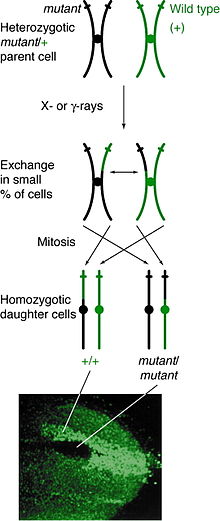Mitotic recombination
Mitotic recombination is a type of
Mitotic homologous recombination occurs mainly between sister chromatids subsequent to replication (but prior to cell division). Inter-sister homologous recombination is ordinarily genetically silent. During mitosis the incidence of recombination between non-sister homologous chromatids is only about 1% of that between sister chromatids.[3]Discovery
The discovery of mitotic recombination came from the observation of twin spotting in Drosophila melanogaster. This twin spotting, or mosaic spotting, was observed in D. melanogaster as early as 1925, but it was only in 1936 that Curt Stern explained it as a result of mitotic recombination. Prior to Stern's work, it was hypothesized that twin spotting happened because certain genes had the ability to eliminate the chromosome on which they were located.[4] Later experiments uncovered when mitotic recombination occurs in the cell cycle and the mechanisms behind recombination.

Occurrence
Mitotic recombination can happen at any locus but is observable in individuals that are heterozygous at a given locus. If a crossover event between non-sister chromatids affects that locus, then both homologous chromosomes will have one
Mitotic recombination takes place during interphase. It has been suggested that recombination takes place during G1, when the DNA is in its 2-strand phase, and replicated during DNA synthesis.[5] It is also possible to have the DNA break leading to mitotic recombination happen during G1, but for the repair to happen after replication.[6][7]
Response to DNA damage
In the budding yeast Saccharomyces cerevisiae, mutations in several genes needed for mitotic (and meiotic) recombination cause increased sensitivity to inactivation by radiation and/or genotoxic chemicals.[8] For example, gene rad52 is required for mitotic recombination[9] as well as meiotic recombination.[10] Rad52 mutant yeast cells have increased sensitivity to killing by X-rays, methyl methanesulfonate and the DNA crosslinking agent 8-methoxypsoralen-plus-UV light, suggesting that mitotic recombinational repair is required for removal of the different DNA damages caused by these agents.
Mechanisms
The mechanisms behind mitotic recombination are similar to those behind meiotic recombination. These include sister chromatid exchange and mechanisms related to DNA double strand break repair by
Method
There are several theories on how mitotic crossover occurs. In the simple crossover model, the two homologous chromosomes overlap on or near a common
Alternatively, a crossover can occur during DNA repair
Advantages and disadvantages
Mitotic crossover is known to occur in D. melanogaster, some asexually reproducing fungi and in normal human cells, where the event may allow normally recessive cancer-causing alleles to be expressed and thus predispose the cell in which it occurs to the development of
References
- ^ a b Hartl, Daniel L. and Maryellen Ruvolo (2012). Genetics: Analysis of Genetics and Genomes. Burlington: Jones & Bartlett.
- ^ PMID 9345110.
- PMID 20177395.
- PMID 17246815.
- PMID 360220.
- ^ PMID 19282969.
- ^ PMID 19282976.
- ^ Haynes, R.H. & Kunz, B.A. (1981). DNA repair and mutagenesis in yeast. In: Strathern, J; Jones, E; Broach J. editors. The Molecular Biology of the Yeast Saccharomyces. Life Cycle and Inheritance. Cold Spring Harbor, N.Y., Cold Spring Harbor Laboratory, 371-414.
- PMID 6987653.
- PMID 17248996.
- PMID 14643432.
- PMID 10357855.
- ^ Helleday, T. "Double-Strand Break Repair via Double Holliday Junctions (Szostak Model)". Animation. MIT.
- PMID 14643432. Archived from the original(PDF) on 24 May 2014. Retrieved 2012-12-26.
- S2CID 21218975.
- PMID 8404527.
- Griffiths et al. 1999. Modern Genetic Analysis. W. H. Freeman and Company.
